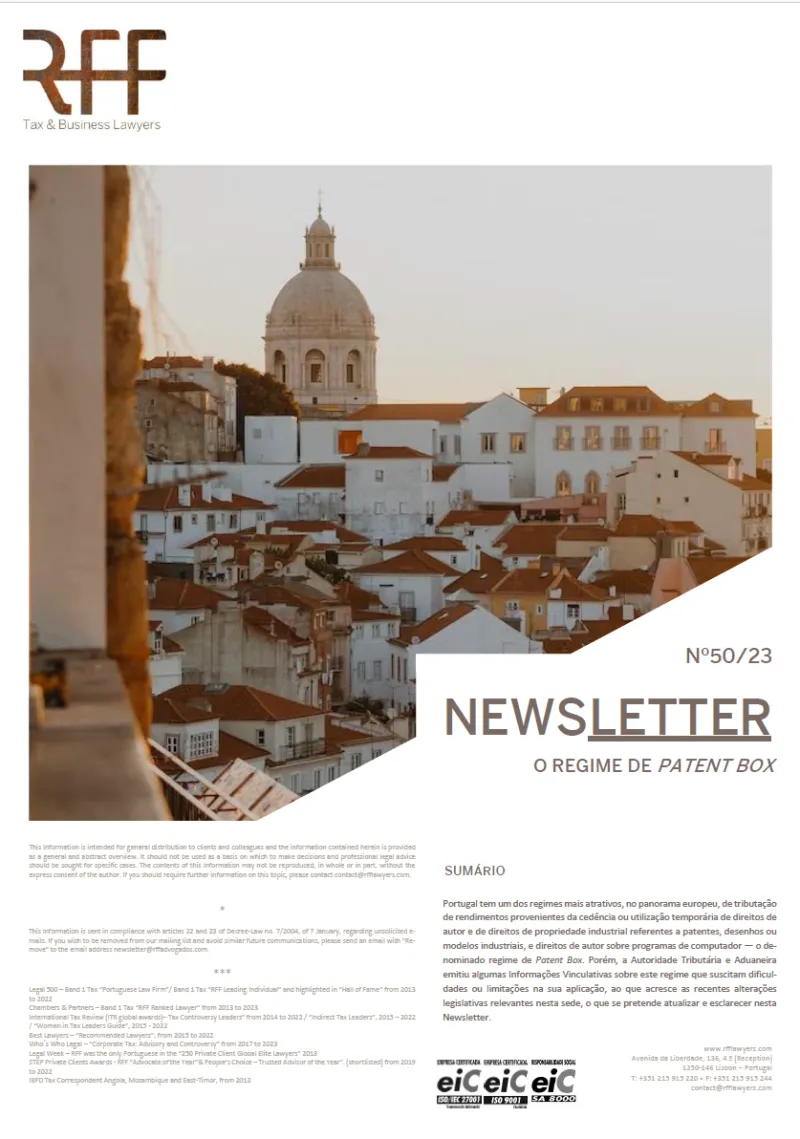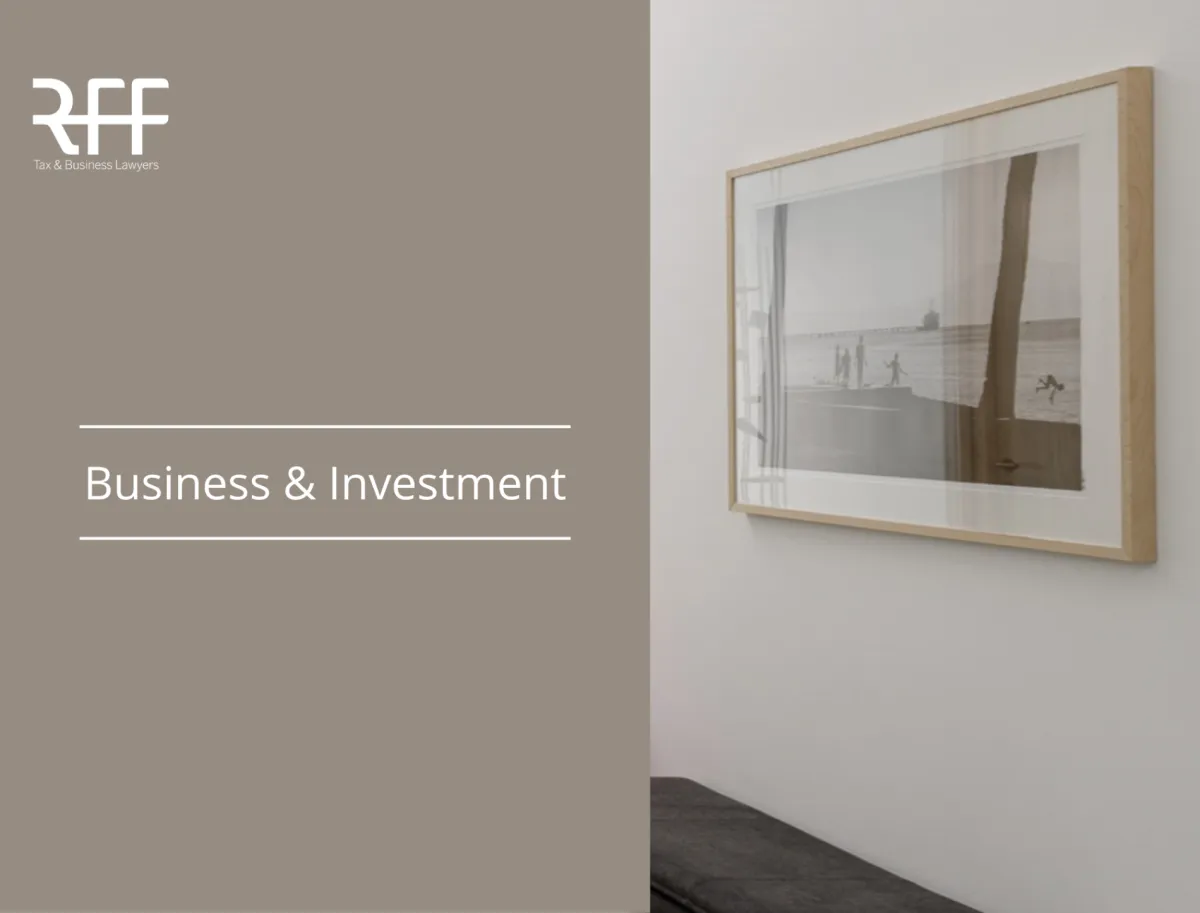Patent Box regime in Portugal

Patent Box regime in Portugal
SUMMARY
Portugal boasts one of the most compelling regimes in the European Union regarding the taxation of income arising from the transfer or temporary assignment of copyrights and industrial property rights. These rights pertain to patents, industrial designs or models, and copyrights on computer programs, falling under the so-called Patent Box regime. Despite some Binding Rulings issued by the Portuguese Tax Authorities that could pose challenges or constraints to the regime's application, recent legislative amendments have been enacted that bring further clarity to this area.
Through this newsletter, our objective is to furnish an update on the application of the Patent Box regime, specifically focusing on the recent legislative modifications.
INTRODUCTION
1.
The Corporate Income Tax Code (CIRC) foresees a special regime to income derived from copyright and industrial property rights, called Patent Box.
This regime, established in 2014, by Law 2/2014 of 16 January, has undergone some changes, the latest in the State Budget Law for 2022 (Law no. 12/2022 of 27 June), which increased the capacity and attractiveness of this regime, in order to make it, as expressed in the State Budget Report for 2022, one of the most attractive in the European Union in this area.
Throughout the historical trajectory of the Patent Box regime, various Binding Rulings have been issued by the Tax Authorities. However, it's important to recognize that there have been instances where the Tax Authorities have, in our view, seemingly erected hurdles that contradict the purpose of the legislator on the progressive enhancement of this regime. This position from the authorities could potentially result in tax litigation, an unfortunate and possibly avoidable circumstance, within this context.
On a positive note, we'd like to bring attention to one of the challenges emerging from a Binding Ruling of the Tax Administration. Notwithstanding, this issue is already surpassed by a very recent legislative amendment, Law No. 20/2023, of 17 May 2023.
THE APPLICABILITY OF THE PATENT BOX REGIME
2.
The Patent Box regime, as it stands, asserts that for the purposes of ascertaining the taxable income of a particular entity, a deduction can be applied, corresponding to the revenue procured from contracts focusing on the transference or lease of certain rights. These rights include patents, industrial designs or models, and copyrights on computer programs.
The effect of this deduction is that only a part of the income obtained is actually taxed, and this taxation may currently be (up to) only 15% of this income (the previous regime allowed a benefit of up to 50% exclusion from taxation of this income, while the current regime, approved by the State Budget Law for 2022, Law n.º 12/2022 of June 27, allows a benefit of up to 85% exclusion from taxation).
Until now, the wording of the regime referred that the deduction was applicable when these rights are "subject to registration". However, in Law No. 20/2023, of 17 May, the wording was amended to "when registered", hence limiting the application of the said regime. It is possible to anticipate that litigation may arise on the effects of this legislative alteration.
The advantages conferred by the Patent Box regime hinge on the concurrent fulfillment of four prerequisites:
(i) The assignee must utilize the rights in the pursuit of commercial, industrial, or agricultural activities.
(ii) The results stemming from the use of the rights by the assignee must not translate into the provision of goods or services that lead to tax-deductible expenses in the assigning entity. This also applies to any entity that is part of a group of companies subjected to the special taxation regime, especially if there exist special relations between the assignee and one or the other.
(iii) The transferee must not be a tax haven resident entity.
(iv) The taxpayer must maintain accounting records, organized in a way that clearly separates these revenues from others, enabling the identification of expenses and losses incurred in research and development activities directly attributable to the right temporarily assigned or used.
3.
In this context, the CIRC also defines that "income from contracts whose object is the temporary assignment or use of rights" is considered to be the net positive balance between the income and gains realized in the tax period in question and the expenses or losses incurred or borne, in the same tax period, by the same entity in the performance of R&D activities that resulted in, or benefited from, the right to which the income is attributable.
Therefore, the advantage of the Patent Box regime becomes essentially apparent when the income derived from the assignment or temporary use of the eligible asset surpasses the cumulative R&D investment expended on the development of that asset.
Considering the tax benefit operates by means of a deduction within the calculation of taxable profit, this deduction is computed and capped by the following formula: DQ/DT x RT x 85%. Here, DQ represents the qualifying expenses incurred in developing the asset (augmented by 30%), DT corresponds to the total expenses incurred in the development of the asset, and RT is the total income sourced from the asset.
It is important to acknowledge that the calculation of gains and losses associated with the asset or right in question should align with the parameters defined in SIFIDE (tax incentive system for corporate R&D). The law also stipulates certain exclusions concerning eligible expenses.
THE CASE OF COPYRIGHTS ON COMPUTER PROGRAMS
4.
Under PIV 22777 and PIV 21235, dated November 15 and December 12, 2022, respectively, the Tax Authorities considered that only income related to "royalties" fall within the scope of article 50. It clarified that software payments are covered by the concept of royalties when only part of the software rights are transferred, regardless of whether the payments are made as retribution for the right to use a software copyright with a view to its commercial exploitation (except for payments related to the right to distribute standardized copies, excluding the right to customize or reproduce them), or are for software purchased by the acquirer for use in the course of a business operation, where in the latter case the software is not entirely standardized but is adapted to the acquirer in some way.
In their evaluation, the tax authorities not only construe eligible income to fall under the category of royalties, but they also seem to classify the income from standard software use licenses—wherein there is no transfer of intellectual property rights and the licensed rights merely permit the end user to utilize the program—as commercial income rather than royalties. This distinction, in their viewpoint, precludes such income from benefiting from the Patent Box regime.
However, we believe that the interpretation proposed by the Tax Administration might unduly restrict the regime's applicability, should one attempt to derive generalized conclusions from it. This interpretation appears to be at odds with the regime's intended purpose, especially regarding its applicability in instances of mere temporary use. This could potentially render this appealing regime obsolete.
OF THE (ALLEGED) LIMIT OF ARTI-CLE 92 OF THE CIRC (CORPORATE INCOME TAX CODE)
5.
Article 92.º, no. 1 of the CIRC states that the tax assessed (...), net of the deductions provided for (...) cannot be less than 90% of the amount that would be calculated if the taxpayer did not enjoy tax benefits and the social utility regime.
In this context, in order to safeguard the usefulness of tax benefits created in separate legislation, the legislator has excluded from the above-mentioned "comparison" a list of tax benefits provided for, for example, in the Investment Tax Code or in the Statute of Tax Benefits (see article 92.º,n.º2).
However, based on the aforementioned paragraph 1 of article 92.º of the CIRC and knowing that the Patent Box regime is not expressly included in the aforementioned paragraph 2 of this article, the Tax Administration, in the scope of PIV 22968, stated that "(...) as article 50-A is not included in the benefits excluded from the application of the limitation [i.e. the minimum limit of tax payable], it is included for the purposes of calculating the limitation provided for in article 92.º of the CIRC.”
6.
However, such an interpretation may practically hinder the efficacy and applicability of the regime—a regime that the legislature expressly intended to be one of the most attractive in the European Union. For instance, its use in the technological sector could be severely limited. If this interpretation is indeed accurate, it would then stand in contradiction to the interests of the legislator, systemic integration, and the underlying rationale of the relevant rules.
In this regard, it should be noted that the already mentioned Law no. 20/2023, of 17 May, adds a paragraph 3 to Article 92.º of the CIRC, which now states that: (…) the tax benefits set out in this Code are not considered to be covered by this article.
To put it differently, this legislative amendment elucidates that the tax benefits outlined in the Corporate Income Tax Code (CIRC) are not taken into account when calculating the minimum limit of tax payable, as per Article 92 of the IRC Code. This essentially precludes the possibility of interpreting that the legislature, within the same code, simultaneously provides tax benefits while also extensively limiting them.
This legislative amendment is commendable, given that it not only aligns with the most accurate interpretation of the rule in question, but also bolsters certainty for economic operators and entities aiming to leverage the Patent Box regime. It's worth noting that the Portuguese Parliament has approved this legislative amendment to carry interpretative effects, hence supporting the view — such as ours, but apparently not the ta authorities’ view — that this was the legislator’s intention since day one.
FINAL OBSERVATIONS
Portugal presents a highly appealing regime for R&D, encompassing the tax benefits for research and development derived from SIFIDE as well as other investment incentives stipulated in the RFAI. These benefits extend to the Patent Box regime, which is one of the most attractive in the European Union. It allows for a tax exclusion of up to 85% on the income derived from the temporary assignment or use of eligible rights, including software. Noteworthy amendments to the Patent Box regime were enacted under Law No. 20/2023, dated 17 May.
Regarding this, we perceive that the transition in wording from "subject to registration" to "when registered"—to which no interpretative effects were ascribed and, in our view, rightly so—could potentially incite or accentuate instances of tax litigation. It may limit the regime's applicability to the transfer or lease of eligible rights that are already registered, thus possibly prompting a delay in the regime's implementation until after the respective registration. Essentially, this could limit the regime's applicability based on an exogenous factor beyond the control or influence of the taxpayer in question.
On the other hand, the legislative amendment that definitively clarifies, with interpretative implications, that there is no limitation to the application of the Patent Box regime by Article 92 of the CIRC is praiseworthy. This clarification enables any taxpayers who have felt constrained by this limitation to potentially assert their entitlement to the tax benefit.
Tax litigation is also expected to increase with regard to the definition of copyrights on computer programs that are valid for the application of the Patent Box regime. Here, the tax authorities seem to have a somewhat restrictive interpretation, apparently positing that only cases where there is a transfer of software ownership rights are considered as income subsumed under the concept of royalties.
In light of these developments, we will remain vigilant, closely monitoring the trajectory of the Patent Box regime and any challenges that may emerge in the future.
***
Lisbon, May 23rd 2023
Rogério Fernandes Ferreira
Marta Machado de Almeida
Álvaro de Silveira Meneses
Miriam Campos Dionísio
João de Freitas Jacob
(Tax Advisory Team)
